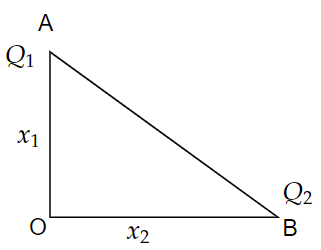
Charges \[{Q_1}\] and \[{Q_2}\]are at points A and B of a right-angle triangle OAB (see figure). The resultant electric field at point O is perpendicular to the hypotenuse, then the ratio of \[\dfrac{{{Q_1}}}{{{Q_2}}}\] is proportional to

A. \[\dfrac{{{x_2}}}{{{x_1}}}\]
B. \[\dfrac{{{x_2}^2}}{{{x_1}^2}}\]
C. \[\dfrac{{{x_1}^3}}{{{x_2}^3}}\]
D. \[\dfrac{{{x_1}}}{{{x_2}}}\]
Answer
218.4k+ views
Hint: Before we start addressing the problem let’s understand the electric field. It is the physical field that surrounds the electrically charged particles and exerts a force on all other charged particles in the field, it may be either attractive or repulsive.
Formula Used:
To find the electric field, we have,
\[E = \dfrac{1}{{4\pi {\varepsilon _0}}}\dfrac{Q}{{{x^2}}}\]
Where, Q is charge, \[{\varepsilon _0}\]is permittivity of free space and $x$ is the distance.
Complete step by step solution:

Image: Charges at points A and B at right angle triangle
Here, the charges \[{Q_1}\] and \[{Q_2}\] are placed at the points A and B of a right-angle triangle OAB. The side \[OA = {x_1}\], \[OB = {x_2}\] and AB is the hypotenuse side. The resultant field at O is perpendicular to the hypotenuse side. Now the electric field at O due to \[{Q_1}\] is \[{E_1}\] and the electric field at O due to \[{Q_2}\] is \[{E_2}\]. The resultant electric field makes an angle \[\theta \] with the vertical. From the figure,
\[\tan \theta = \dfrac{{{E_2}}}{{{E_1}}}\] ……. (1)
We know that from the formula of electric charge,
\[E = \dfrac{1}{{4\pi {\varepsilon _0}}}\dfrac{Q}{{{x^2}}}\]
We can write for \[{E_1}\] and \[{E_2}\] as,
\[{E_1} = \dfrac{1}{{4\pi {\varepsilon _0}}}\dfrac{{{Q_1}}}{{{x_1}^2}}\] and \[{E_2} = \dfrac{1}{{4\pi {\varepsilon _0}}}\dfrac{{{Q_2}}}{{{x_2}^2}}\]
Substitute the value in equation (1) we get,
\[\tan \theta = \dfrac{{\left( {\dfrac{1}{{4\pi {\varepsilon _0}}}\dfrac{{{Q_2}}}{{{x_2}^2}}} \right)}}{{\left( {\dfrac{1}{{4\pi {\varepsilon _0}}}\dfrac{{{Q_1}}}{{{x_1}^2}}} \right)}}\]
\[\Rightarrow \tan \theta = \dfrac{{\left( {\dfrac{{{Q_2}}}{{{x_2}^2}}} \right)}}{{\left( {\dfrac{{{Q_1}}}{{{x_1}^2}}} \right)}}\]
\[\Rightarrow \tan \theta = \dfrac{{{Q_2}}}{{{x_2}^2}} \times \dfrac{{{x_1}^2}}{{{Q_1}}}\]……… (2)
From the right-angle triangle OBA,
\[\tan \theta = \dfrac{{{x_1}}}{{{x_2}}}\]………… (3)
Equate equations (2) and (3) we get,
\[\dfrac{{{Q_2}}}{{{x_2}^2}} \times \dfrac{{{x_1}^2}}{{{Q_1}}} = \dfrac{{{x_1}}}{{{x_2}}}\]
\[\Rightarrow \dfrac{{{Q_2}}}{{{Q_1}}} = \dfrac{{{x_2}}}{{{x_1}}}\]
\[ \therefore \dfrac{{{Q_1}}}{{{Q_2}}} = \dfrac{{{x_1}}}{{{x_2}}}\]
Therefore, the resultant electric field at point O is perpendicular to the hypotenuse, then the ratio of \[\dfrac{{{Q_1}}}{{{Q_2}}}\] is proportional to \[\dfrac{{{x_1}}}{{{x_2}}}\].
Hence, Option D is the correct answer.
Note:Here in this given problem it is important to remember to brush up on the trigonometric fundamentals such as sine, cos, tan functions etc. Moreover, an electric field may be thought of as an electric property associated with every place in space where a charge exists in any form. The electric force per unit charge is another way to characterise an electric field.
Formula Used:
To find the electric field, we have,
\[E = \dfrac{1}{{4\pi {\varepsilon _0}}}\dfrac{Q}{{{x^2}}}\]
Where, Q is charge, \[{\varepsilon _0}\]is permittivity of free space and $x$ is the distance.
Complete step by step solution:

Image: Charges at points A and B at right angle triangle
Here, the charges \[{Q_1}\] and \[{Q_2}\] are placed at the points A and B of a right-angle triangle OAB. The side \[OA = {x_1}\], \[OB = {x_2}\] and AB is the hypotenuse side. The resultant field at O is perpendicular to the hypotenuse side. Now the electric field at O due to \[{Q_1}\] is \[{E_1}\] and the electric field at O due to \[{Q_2}\] is \[{E_2}\]. The resultant electric field makes an angle \[\theta \] with the vertical. From the figure,
\[\tan \theta = \dfrac{{{E_2}}}{{{E_1}}}\] ……. (1)
We know that from the formula of electric charge,
\[E = \dfrac{1}{{4\pi {\varepsilon _0}}}\dfrac{Q}{{{x^2}}}\]
We can write for \[{E_1}\] and \[{E_2}\] as,
\[{E_1} = \dfrac{1}{{4\pi {\varepsilon _0}}}\dfrac{{{Q_1}}}{{{x_1}^2}}\] and \[{E_2} = \dfrac{1}{{4\pi {\varepsilon _0}}}\dfrac{{{Q_2}}}{{{x_2}^2}}\]
Substitute the value in equation (1) we get,
\[\tan \theta = \dfrac{{\left( {\dfrac{1}{{4\pi {\varepsilon _0}}}\dfrac{{{Q_2}}}{{{x_2}^2}}} \right)}}{{\left( {\dfrac{1}{{4\pi {\varepsilon _0}}}\dfrac{{{Q_1}}}{{{x_1}^2}}} \right)}}\]
\[\Rightarrow \tan \theta = \dfrac{{\left( {\dfrac{{{Q_2}}}{{{x_2}^2}}} \right)}}{{\left( {\dfrac{{{Q_1}}}{{{x_1}^2}}} \right)}}\]
\[\Rightarrow \tan \theta = \dfrac{{{Q_2}}}{{{x_2}^2}} \times \dfrac{{{x_1}^2}}{{{Q_1}}}\]……… (2)
From the right-angle triangle OBA,
\[\tan \theta = \dfrac{{{x_1}}}{{{x_2}}}\]………… (3)
Equate equations (2) and (3) we get,
\[\dfrac{{{Q_2}}}{{{x_2}^2}} \times \dfrac{{{x_1}^2}}{{{Q_1}}} = \dfrac{{{x_1}}}{{{x_2}}}\]
\[\Rightarrow \dfrac{{{Q_2}}}{{{Q_1}}} = \dfrac{{{x_2}}}{{{x_1}}}\]
\[ \therefore \dfrac{{{Q_1}}}{{{Q_2}}} = \dfrac{{{x_1}}}{{{x_2}}}\]
Therefore, the resultant electric field at point O is perpendicular to the hypotenuse, then the ratio of \[\dfrac{{{Q_1}}}{{{Q_2}}}\] is proportional to \[\dfrac{{{x_1}}}{{{x_2}}}\].
Hence, Option D is the correct answer.
Note:Here in this given problem it is important to remember to brush up on the trigonometric fundamentals such as sine, cos, tan functions etc. Moreover, an electric field may be thought of as an electric property associated with every place in space where a charge exists in any form. The electric force per unit charge is another way to characterise an electric field.
Recently Updated Pages
A square frame of side 10 cm and a long straight wire class 12 physics JEE_Main

The work done in slowly moving an electron of charge class 12 physics JEE_Main

Two identical charged spheres suspended from a common class 12 physics JEE_Main

According to Bohrs theory the timeaveraged magnetic class 12 physics JEE_Main

ill in the blanks Pure tungsten has A Low resistivity class 12 physics JEE_Main

The value of the resistor RS needed in the DC voltage class 12 physics JEE_Main

Trending doubts
JEE Main 2026: Application Form Open, Exam Dates, Syllabus, Eligibility & Question Papers

Derivation of Equation of Trajectory Explained for Students

Hybridisation in Chemistry – Concept, Types & Applications

Understanding the Angle of Deviation in a Prism

Understanding Collisions: Types and Examples for Students

Understanding Atomic Structure for Beginners

Other Pages
JEE Advanced Marks vs Ranks 2025: Understanding Category-wise Qualifying Marks and Previous Year Cut-offs

How to Convert a Galvanometer into an Ammeter or Voltmeter

Understanding Centrifugal Force in Physics

Ideal and Non-Ideal Solutions Explained for Class 12 Chemistry

Degree of Dissociation: Meaning, Formula, Calculation & Uses

Understanding Electromagnetic Waves and Their Importance




